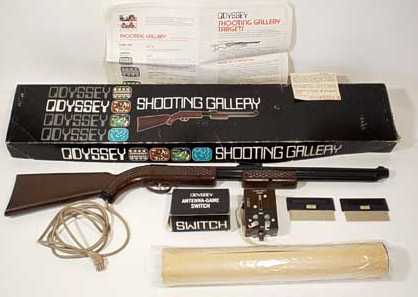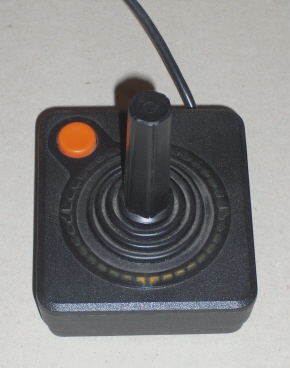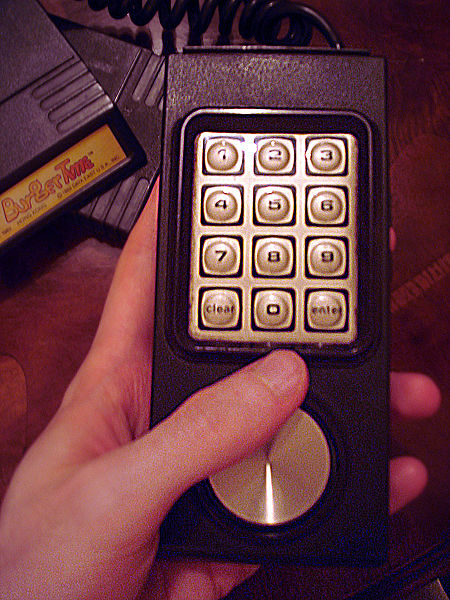Magnavox Odyssey
 The other controller later came out for the system and did revolutionize console gaming. The light gun for the Magnavox Odyssey was the first of its kind sold at retail. The gun would detect light that would flash on the screen when you pulled the trigger. If your gun was aimed at the white light then you hit your target. This light gun was the size of a rifle and looked realistic, something that has not been copied too much since (mostly because of laws stating that you cannot make realistic guns as toys).
The other controller later came out for the system and did revolutionize console gaming. The light gun for the Magnavox Odyssey was the first of its kind sold at retail. The gun would detect light that would flash on the screen when you pulled the trigger. If your gun was aimed at the white light then you hit your target. This light gun was the size of a rifle and looked realistic, something that has not been copied too much since (mostly because of laws stating that you cannot make realistic guns as toys).Game types - As stated before because of the simplicity of the hardware and the controller all the games had to revolve around just 2 blocks moving around and sometimes an additional small block used as a weapon or ball.
Atari 2600
 It was 5 years later in 1977 that any big change came to the home console market. The Atari 2600 was a big success and one of the things that helped it was the controller. Arcade gaming was still popular in the late 70s and early 80s and most of these games featured a joystick and a few buttons. Atari brought the joystick into the home which many gamers were already used to. Since the control was so similiar to the arcade it was easier to bring the arcade experience home. Controlling with the stick was much easier than using dials. It felt a lot more natural and offered the player more control over the content in the game. The Atari controller also placed a small red fire button on the controller. Having only one button limited the type of games that could be played, but most games at the time were fairly simple anyways. A single fire button was usually sufficiant for most games in the late 70s and early 80s. It seems simple but adding a button brought a lot more depth to the gameplay, you can now not only control the direction of the characters but the actions as well.
It was 5 years later in 1977 that any big change came to the home console market. The Atari 2600 was a big success and one of the things that helped it was the controller. Arcade gaming was still popular in the late 70s and early 80s and most of these games featured a joystick and a few buttons. Atari brought the joystick into the home which many gamers were already used to. Since the control was so similiar to the arcade it was easier to bring the arcade experience home. Controlling with the stick was much easier than using dials. It felt a lot more natural and offered the player more control over the content in the game. The Atari controller also placed a small red fire button on the controller. Having only one button limited the type of games that could be played, but most games at the time were fairly simple anyways. A single fire button was usually sufficiant for most games in the late 70s and early 80s. It seems simple but adding a button brought a lot more depth to the gameplay, you can now not only control the direction of the characters but the actions as well.Game types - Because the controller was so limited with just a joystick and one action button games basically had just a single character to control and it usually could fire something, or jump but not both.
Intellivision
 In 1980 the Intellivision hit and with it brought some new controls. Rather than having a joystick, it had a disc that could move in 16 directions. The disc was more advanced than the Atari joystick but because of its design it was not the easiest to manipulate. The controller also has a full keypad and 4 buttons on the side. The side buttons were somewhat difficult to use effectively depending on how you held the controller, while the keypad could only be used when you were not using the control disc. Because you could not manipulate the disc and the keypad at the same time players would sometimes have to use two controllers at once (one for the keys and one for directions). This was not a comfortable situation. The intellivision controller was advanced in many ways (having more buttons allowed for more action on the screen and more control over the game) but had too many hardware issues to truely be amazing.
In 1980 the Intellivision hit and with it brought some new controls. Rather than having a joystick, it had a disc that could move in 16 directions. The disc was more advanced than the Atari joystick but because of its design it was not the easiest to manipulate. The controller also has a full keypad and 4 buttons on the side. The side buttons were somewhat difficult to use effectively depending on how you held the controller, while the keypad could only be used when you were not using the control disc. Because you could not manipulate the disc and the keypad at the same time players would sometimes have to use two controllers at once (one for the keys and one for directions). This was not a comfortable situation. The intellivision controller was advanced in many ways (having more buttons allowed for more action on the screen and more control over the game) but had too many hardware issues to truely be amazing.One unique and fun thing about the controller was the overlays you could put over the keypad. Each game had its own control scheme and many players were not used to using a full keypad for console games. In order to help the player, he/she could use a controller overlay that would tell you which button did what.
ColecoVision
 Coming out 2 years later than the Intellivision, in 1982, the ColecoVision did a lot of things right with the controller. The control disc was raised and created a hybrid disc/joystick that was much easier to use. Unlike the Atari joystick you could control it with just your thumb and like the Intellivision disc it had a lot more movement. Because you only had to use your thumb it kept the rest of your hand free to press other buttons, allowing more action to happen on the screen. The keypad and overlay was also replicated from the Intellivision. Overall this controller was everything the Intellivision controller could have been if it just spent a bit more time in product testing.
Coming out 2 years later than the Intellivision, in 1982, the ColecoVision did a lot of things right with the controller. The control disc was raised and created a hybrid disc/joystick that was much easier to use. Unlike the Atari joystick you could control it with just your thumb and like the Intellivision disc it had a lot more movement. Because you only had to use your thumb it kept the rest of your hand free to press other buttons, allowing more action to happen on the screen. The keypad and overlay was also replicated from the Intellivision. Overall this controller was everything the Intellivision controller could have been if it just spent a bit more time in product testing.
Game types - Both the ColecoVision and the Intellivison were very similar in execution and games because of there similiar controllers. Games now had much more they could do and the overlay allowed for a more complex series of actions the character on the screen could prefrom.
Nintendo Entertainment System Even though the NES came out in Japan in 1983, under the name Famicom, the controller was basically a copy of Nintendo's Game and Watch, which came out in 1980. The controller was simple as it had only two buttons and a directional pad. The directional pad was where the real change to gaming came from. It was a slightly raised cross but offered precise control. Because it was such a small directional pad it was the first controller that could be held comfortably. It just fit in the player's hand and you could access all the buttons you need with your thumbs. Taking away the complexities of the previous controllers on the market the NES quickly became an accessible and hot selling machine. Even though the controller did not have as many action buttons, because of how easy and comfortable it was to use the games could be faster and more action paced without losing the player. The joysticks and keypads of previous systems were completely scrapped, and to this day all video game controllers are built off of the foundation that the NES controller laid.
Even though the NES came out in Japan in 1983, under the name Famicom, the controller was basically a copy of Nintendo's Game and Watch, which came out in 1980. The controller was simple as it had only two buttons and a directional pad. The directional pad was where the real change to gaming came from. It was a slightly raised cross but offered precise control. Because it was such a small directional pad it was the first controller that could be held comfortably. It just fit in the player's hand and you could access all the buttons you need with your thumbs. Taking away the complexities of the previous controllers on the market the NES quickly became an accessible and hot selling machine. Even though the controller did not have as many action buttons, because of how easy and comfortable it was to use the games could be faster and more action paced without losing the player. The joysticks and keypads of previous systems were completely scrapped, and to this day all video game controllers are built off of the foundation that the NES controller laid. The NES light gun also deserves a mention. It used the same technology the Magnovox one did but it was much lighter and more compact.
The NES light gun also deserves a mention. It used the same technology the Magnovox one did but it was much lighter and more compact.
 The Japanese Controllers were different in colour scheme as well as having one extra feature. The second controller had a microphone on it. The mic wasn't used in many games (I can only think of one) and all it did was allow the player to project his/her voice on the TV speakers.
The Japanese Controllers were different in colour scheme as well as having one extra feature. The second controller had a microphone on it. The mic wasn't used in many games (I can only think of one) and all it did was allow the player to project his/her voice on the TV speakers. Finally in 1993 the NES under went a re-design. The controllers were functionally the same but were now curved and felt more comfortable.
Finally in 1993 the NES under went a re-design. The controllers were functionally the same but were now curved and felt more comfortable.
Game types - Even though it scalled back on the buttons the games were far superior to those on any console before. With just two action buttons and a control pad the NES could pull off fast action games, racing games, and RPGs with ease. However all these games were fairly simple in design.
Sega Genesis (3 button)
 In 1989, Sega released its 3rd major console (the SG-1000, and the Sega master system were the previous two). The Genesis, or Mega Drive as it is called in many other parts of the world, was the first console to really bring in a revolutionary controller. As stated before too many buttons can get a bit too complicated, but the NES had only 2 buttons which limited the amount of actions the player could preform. The Sega Genesis had three buttons all lined up in a row. The player could easily rest his/her thumb in the middle and reach all three buttons. The Sega Genesis was the first 16 bit system and the first to bring truely powerful arcade quality graphics to the home. Because, it was so much more powerful than anything before it, it needed the extra inputs to keep up with how games were evolving. Sega also upgraded the D-pad making it multidirectional. Rather than having just up, down, left, and, right it also included the diagonals. This added a greater deal of control over the characters on the screen while remaining compact and easy to use.
In 1989, Sega released its 3rd major console (the SG-1000, and the Sega master system were the previous two). The Genesis, or Mega Drive as it is called in many other parts of the world, was the first console to really bring in a revolutionary controller. As stated before too many buttons can get a bit too complicated, but the NES had only 2 buttons which limited the amount of actions the player could preform. The Sega Genesis had three buttons all lined up in a row. The player could easily rest his/her thumb in the middle and reach all three buttons. The Sega Genesis was the first 16 bit system and the first to bring truely powerful arcade quality graphics to the home. Because, it was so much more powerful than anything before it, it needed the extra inputs to keep up with how games were evolving. Sega also upgraded the D-pad making it multidirectional. Rather than having just up, down, left, and, right it also included the diagonals. This added a greater deal of control over the characters on the screen while remaining compact and easy to use.Game Types - With an extra action button it added a new layer to the NES controller. It had many similar types of games but they could now preform more actions on the screen. The Genesis controller also allowed one of the earliest Real Time Stradegy games, "Herzog Zwei", to be played
No comments:
Post a Comment